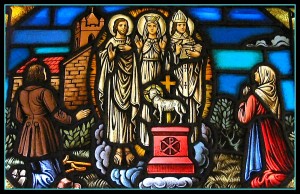 A Marian apparition is a supernatural appearance of the Virgin Mary. One of the most famous examples from our history is Mary giving St. Bernard of Clairvaux the ‘Hail Mary’. The Church treats apparitions as private revelations that can never add anything new to the faith. An authentic apparition is believed not to be a subjective experience, but a real and objective intervention of divine power. The purpose of such apparitions is to recall and emphasize some aspect of the Christian message. The Church states that cures and other miraculous events are not the purpose of Marian apparitions, but exist primarily to validate and draw attention to the message. Marian apparitions are regarded as evidence of Mary’s continuing active presence in the life of the church, through which she ‘cares for the brethren of her Son who still journey on the earth’ (Lumen Gentium, 62).The Roman Catholic Church may pronounce an apparition as worthy of belief, but belief in an apparition is never required by divine faith. According to the Church, the era of public revelation ended with the death of the last living apostle.
A Marian apparition is a supernatural appearance of the Virgin Mary. One of the most famous examples from our history is Mary giving St. Bernard of Clairvaux the ‘Hail Mary’. The Church treats apparitions as private revelations that can never add anything new to the faith. An authentic apparition is believed not to be a subjective experience, but a real and objective intervention of divine power. The purpose of such apparitions is to recall and emphasize some aspect of the Christian message. The Church states that cures and other miraculous events are not the purpose of Marian apparitions, but exist primarily to validate and draw attention to the message. Marian apparitions are regarded as evidence of Mary’s continuing active presence in the life of the church, through which she ‘cares for the brethren of her Son who still journey on the earth’ (Lumen Gentium, 62).The Roman Catholic Church may pronounce an apparition as worthy of belief, but belief in an apparition is never required by divine faith. According to the Church, the era of public revelation ended with the death of the last living apostle.
An approved Marian apparition is one that has been examined by the Congregation for the Doctrine of the Faith and has been granted approval either through the local Bishop based on the direction of the Congregation for the Doctrine of the Faith or received direct approval from the Vatican. The Vatican has officially confirmed the apparitions at Guadalupe (Mexico), Saint-Etienne-le-Laus (France), Paris (the Miraculous Medal apparition), La Salette (France), Lourdes (France), Knock (Ireland), Fatima (Portugal), Pontmain (France), Beauring (Belgium), and Banneux (Belgium). Of the 295 reported apparitions studied by the Vatican only these have been approved, the latest being the May 2008 approval of the apparitions of Our Lady of Laus. Other apparitions continue to be approved at the local level such as the December 2010 local approval of the 19th century apparitions of Our Lady of Good Help, the first recognized apparition in the United States.
Although a local bishop may provide a preliminary assessment (and allow the devotion to proceed forward), formal approval can only be provided after detailed analysis by the Vatican. For instance, although the apparitions at Our Lady of Laus were recognized by the local diocese in 1665, they received approval from the Congregation for the Doctrine of the Faith centuries later, in 2008.
Finally, the subsequent behavior of those who are the principal recipients of the apparition is examined and compared with the behavior of Bernadette following the apparitions at Lourdes. It is assumed that being present at an authentic apparition will lead to a holy life.
Some Protestant Christians and non-Christians regard claims of Marian apparitions as being hallucinations encouraged by superstitions and occasionally simply as deliberate hoaxes to attract attention. Many such apparitions are reported in economically depressed areas, attracting many pilgrims who bring trade and money into the region. For instance, some sources dispute the very existence of San Juan Diego. In contrast however, the Anglican Communion has officially recognized the apparition of Our Lady of Lourdes and has built an Anglican Marian Shrine on the location, close to the Roman Catholic shrine. In September 2008, Rowan Williams, then Archbishop of Canterbury and Leader of the Anglican Communion, made a pilgrimage to Lourdes and preached at the shrine. Also the Anglicans have re-established the premier English pilgrimage site of Our Lady of Walsingham, which commemorates a Marian apparition at that site dating to 1061.
Two series of reported apparitions, neither of which have been officially approved, have caused significant interest within the Roman Catholic Church in recent years. The first involves apparitions to six children in Medjugorje in 1981, reports of which were vigorously opposed by the local bishop. In 1991, the Bishops Conference of Yugoslavia stated, ‘On the basis of the investigations so far it cannot be affirmed that one is dealing with supernatural apparitions and revelations’. However on March 17, 2010, the Vatican announced it was beginning a formal investigation of the apparitions at Medjugorje.
The second series of reported apparitions date from 1961 to 1965, at Garabandal in Northern Spain. However, when examined by the local Bishop, they were declared as not having evidence of being of supernatural origin. However the apparitions were not declared a hoax and the possibility of future approval was left open.
In conclusion, Marian Apparitions are a help God gives us to bring us closer to Jesus Christ as our Lord and Savior. To quote St. Louis de Montfort, ‘to Christ through Mary!’ If these apparition do not help build our relationship with Christ, then we are not obliged to pay them any attention, but we must not interfere with others who may find them helpful.

